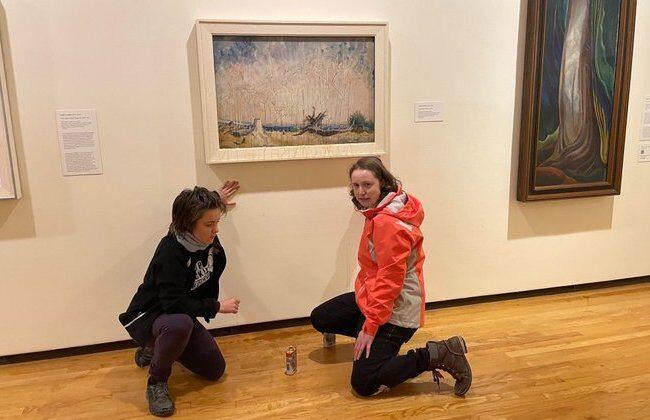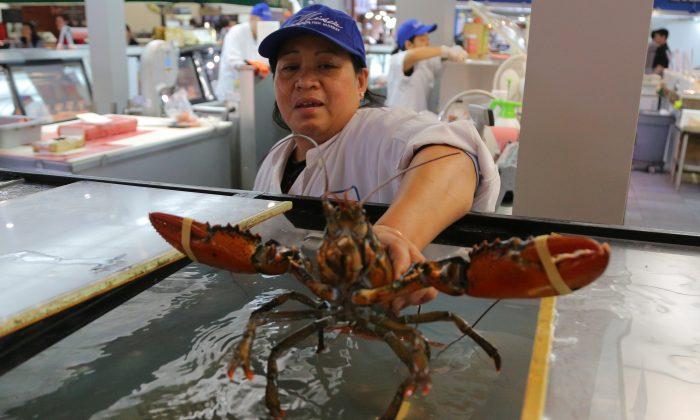Two women claiming to be climate activists allegedly vandalized an Emily Carr painting titled “Stumps and Sky” at the Vancouver Art Gallery on Nov. 12 and then issued a press release on Twitter saying it was to demand an end to the Coastal GasLink Pipeline in Northern B.C.
Erin Fletcher, 19, and Emily Kelsall from a group called Stop Fracking Around were videotaped throwing maple syrup on the glass-encased 1934 painting and then apparently gluing their hands to the gallery wall.
The action was taken “in the hopes of bringing attention to the drilling under the Wedzin Kwa River on Wet’suwet'en lands in Northern BC, Canada,” as “We are in a climate emergency,” the press release states.
Vancouver police said an investigation is underway.
The Vancouver Art Gallery said in a news release that “there will be no permanent damage to the artwork” but that it “condemns this act.”
Don Marshall, spokesperson for the activist group, told The Globe and Mail that the group was mimicking European climate protesters who have targeted various famous artworks.
Among the most well-known was Leonardo da Vinci’s Mona Lisa in Paris. An individual disguised in a wig and pretending to need a wheelchair as a ploy to get closer to the artwork threw cake at the bulletproof glass-protected painting at the Musee du Louvre on May 29.
‘Irreplaceable Objects’
On Nov. 11, two climate activists reportedly tried to glue themselves to Edvard Munch’s 1893 painting “The Scream” at the National Museum of Norway in Oslo. The painting was protected by glass, but the vandalism left glue residue on the glass. The museum closed the room where the painting was exhibited to the public as a result of the incident.Stopp oljeletinga, or Norwegian for Stop Oil Exploration, claimed responsibility for the stunt, saying it was “to pressure lawmakers into stopping oil exploration.”
Spokeswoman Astrid Rem told The Associated Press: “There have been lots of similar actions around Europe, they have managed something that no other action has managed: achieve an extremely large amount of coverage and press.”
The International Community of Museums (ICOM) issued a joint statement on Nov. 9, signed by almost 100 museum directors, saying, “In recent weeks, there have been several attacks on works of art in international museum collections. The activists responsible for them severely underestimate the fragility of these irreplaceable objects, which must be preserved as part of our world cultural heritage.”
The signatories including directors from the Met and the Guggenheim Museum in New York, the Louvre and Musée d'Orsay in Paris, the Museo Nacional del Prado in Madrid, the British Museum and The National Gallery in London, and the Berlinische Galerie in Berlin.
The U.S.-based Association of Art Museum Directors tweeted on Nov. 3 about the rise in activist attacks against valuable art.
“Attacks on works of art cannot be justified, whether the motivations are political, religious, or cultural,” it said. “Such protests are misdirected and the ends do not justify the means.”
On Oct. 27, a man apparently tried to glue his head to Dutch artist Johannes Vermeer’s “Girl with a Pearl Earring” painting at the Mauritshuis museum in The Hague, Netherlands, while another man glued his own hand to the wall next to the painting. The two Belgian protesters, who were wearing Just Stop Oil T-shirts in the incident, were both sentenced to two months in prison, according to ARTnews.
On Oct. 23, protestors threw mashed potatoes at a Claude Monet painting, which was enclosed in glass, at the Barberini Museum in Potsdam, Germany, and then glued themselves to the wall to protest fossil fuels, AP reported.
Two British protestors from Just Stop Oil threw tomato soup at Vincent van Gogh’s “Sunflowers” painting in London’s National Gallery on Oct. 14, and then glued themselves to the wall, according to AP. The glass-covered painting was not damaged.
The same group apparently attacked Leonardo da Vinci’s “The Last Supper” at London’s Royal Academy of Arts in July, Daily Mail reported.





